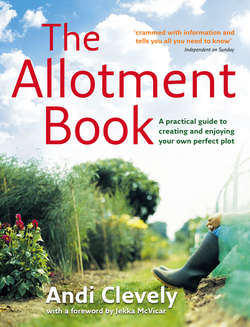Читать книгу The Allotment Book - Andi Clevely - Страница 54
GROWING FOR SHOW
ОглавлениеRivalry is traditional on allotments and there will often be an annual show for the best produce: you have every right to be proud of a good crop and might like to consider entering a particularly outstanding sample. Growing crops for competition, however, involves dedication, careful attention to detail and even esoteric growing methods (these are widely alleged but seldom revealed). Special seed varieties, an early start under glass to ensure the longest possible growing season and lavish preparation are usually essential, as well as a knowledge of class qualifying rules in the show schedule. Winning is immensely satisfying, but it is a good idea to wait until you are experienced at raising conventional crops before venturing into this challenging field, where the size, appearance and grooming of the entry often count for more than consumer delight.
Don’t ignore marginal or less familiar crops, though: the plot is yours for growing almost anything you choose. You might like to try Asian vegetables like karella or chick peas, grains such as wild rice or bread wheat, grapes for wine-making, or those crops that are generally unobtainable in shops, for example, whitecurrants, hyacinth beans, golden raspberries, skirret or fresh fenugreek.
DESIRABLE QUALITIES Even the dourest gardener looks forward to the arrival of seed and plant lists in the winter – the annual opportunity to dream and experiment. Choices on offer may seem bewildering, especially varieties of popular crops like peas, peppers and tomatoes. The best catalogues give an honest appraisal of varieties, although you sometimes need to read between the lines, especially with new, highly praised introductions. Don’t readily abandon a dependable, old variety for a new, untried one; always grow it alongside for comparison first. Characteristics you might want to consider include:
Eating quality This is probably the most important characteristic, and includes flavour and texture as well as nutritional value.
Tolerance Hardiness and resistance to pests, diseases or drought all reduce the need for intervention or treatment.
Appearance We eat with our eyes, so crop size, shape and colour may be important, as are height and spread.
Time to maturity This helps you allocate space and plan early or successional sowings.
Performance Includes quick germination and predictable growth under a range of conditions.
Ease of care Self-supporting or self-blanching, easy to harvest or quick to prepare.
Adaptability Flexible sowing times or growing methods, or perhaps ability to overwinter.
Keeping time Stays good when mature or stores well.
SEE ALSO ▸ Crop rotation pages 32–5 Sowing & planting times pages 132–3 Keeping your plants healthy pages 154–7 Harvesting & storing pages 160–3
